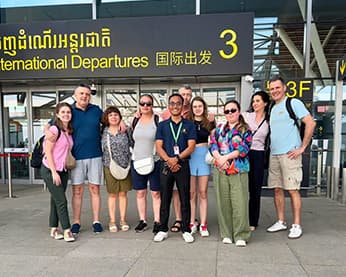Vietnam War History – Tracing the Past, Honoring the Present
The Vietnam War remains one of the most defining and controversial conflicts of the 20th century. Known in Vietnam as the “American War”, it lasted from 1955 to 1975 and left an indelible mark not only on the Vietnamese people but also on generations of American, Australian, South Korean, and allied soldiers who served there. Today, Vietnam has transformed itself into a peaceful and vibrant country yet the traces of war, both physical and emotional, are still present in its landscapes, museums, and living memory.
For travelers seeking to connect with this powerful chapter of history, Vietnam offers a rare and moving journey. Whether you’re a former soldier returning to familiar ground, a child or grandchild tracing family footsteps, or simply a history enthusiast, the experience of walking through wartime locations can be deeply meaningful and unforgettable.
🧭 Understanding the Vietnam War: A Brief Overview
The war was rooted in a complex web of Cold War politics, Vietnamese nationalism, and post-colonial tensions. It began as a civil conflict between North Vietnam (supported by the Soviet Union, China, and communist allies) and Southern Vietnam (backed by the United States and anti-communist countries). Over time, it escalated into a major military campaign, involving over half a million U.S. troops at its peak.
From guerrilla warfare in the jungles to aerial bombings, chemical defoliants, and urban combat, the Vietnam War introduced new strategies and devastating consequences. By 1975, after years of bloody fighting, the war ended with the fall of Saigon, and the country was reunified under communist rule.
Despite the destruction, today’s Vietnam tells not only a story of war, but also of healing, resilience, and progress.
🇻🇳 Top Historical Sites to Explore Vietnam War History
1. Cu Chi Tunnels (Ho Chi Minh City)
One of the most visited war sites in Vietnam, the Cu Chi Tunnels reveal the underground life of the Viet Cong during the war. Stretching over 250 kilometers, these narrow passages were used to house soldiers, transport weapons, and launch surprise attacks. Visitors can crawl through parts of the tunnel system and learn about booby traps, hidden bunkers, and local ingenuity.
2. War Remnants Museum (Ho Chi Minh City)
Located in central Saigon, this museum holds powerful exhibits on the war’s human cost. Photos, military hardware, and reconstructions of prison cells illustrate the trauma of war and the global opposition to it. While emotional, it is one of the most important museums to understand the Vietnamese perspective of the conflict.
3. Long Tan & Nui Dat Battlefield (Ba Ria – Vung Tau Province)
For Australian and New Zealand veterans, Long Tan is hallowed ground. The 1966 Battle of Long Tan was one of the most significant engagements involving ANZAC forces. A memorial now stands at the rubber plantation where the clash occurred. Nearby, the old Nui Dat base can also be visited by those with connections to the region.
4. Hue Imperial City (Thua Thien-Hue Province)
The ancient capital of Hue saw some of the fiercest fighting during the 1968 Tet Offensive, particularly within the walls of the Imperial Citadel. Many parts of this UNESCO World Heritage site were damaged or destroyed during the battle. Today, restored palaces and bullet-marked gates sit side by side, telling a tale of both grandeur and conflict.
5. Demilitarized Zone (DMZ) & Vinh Moc Tunnels (Quang Tri Province)
The 17th parallel once divided North and South Vietnam, and the DMZ was one of the most dangerous areas during the war. Explore Khe Sanh Combat Base, the Rockpile, and Dakrong Bridge – all former military outposts. Nearby, the Vinh Moc Tunnels offer a haunting look at civilian life underground during intense bombing campaigns.
6. Khe Sanh Combat Base
One of the most dramatic sieges of the war took place here in 1968. Visitors can explore remnants of the airstrip, a museum, and original bunkers, all surrounded by the quiet hills that once echoed with gunfire.
7. Hoa Lo Prison (Hanoi)
Nicknamed the “Hanoi Hilton” by American POWs, this prison housed captured U.S. pilots, including John McCain. Today, it serves as a museum, showcasing the harsh conditions during French colonial rule and its use during the Vietnam War.
🌿 The Legacy of War – Reconciliation and Remembrance
Though the scars of war run deep, modern Vietnam is a country of healing and hope. Former battlefields are now peaceful parks. War bunkers sit beside cafes. And locals, including veterans on both sides, are eager to share stories – not of hatred, but of strength, forgiveness, and moving forward.
For U.S. veterans and their families, returning to Vietnam is often a profound experience. Some come for closure, others for healing, and many to show the younger generation what once was. The hospitality and warmth extended by Vietnamese people often surprise visitors, turning a journey into something personal and transformative.
🚐 Plan Your Vietnam War History Tour
Vietnam today has preserved and curated many of its wartime sites to help future generations understand the cost of conflict and the value of peace. Whether you want to walk the Cu Chi Tunnels, stand at Long Tan, or reflect quietly in Vinh Moc, there’s a story waiting for you.
✅ Vietnam Private Tours can arrange all tours for U.S. veterans, families, and history travelers looking to reconnect with Vietnam’s war legacy.
Our team can help you build a personalized itinerary – whether it’s visiting former bases, paying respects at memorials, exploring hidden tunnels, or combining it all with cultural and natural highlights across the country.
Let us help you retrace history – with respect, care, and meaning.



